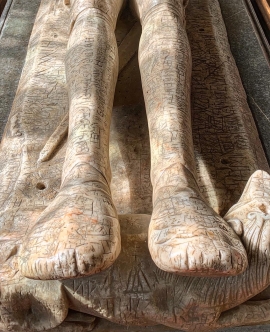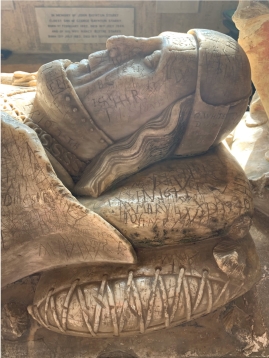In alabaster, with his hound, Sir Roger Toocotes lies. His tomb, from 1492, emphatically life-sized, is a visitor’s book of crooked graffiti. Roundhead troops, Sunday school pupils, even two former rectors have initialled every inch of him, until he has two coats indeed – one the clean, cream surface and another this riot of tattoos, this insistent Who’s Who.

There is no service being held at St Nicholas, Bromham, but rarely have I stood in a church so crowded with absentees. At every turn a Dives, needing to be heard from eternity. “As I was, so are yee: as I am, so shall you bee”, implores an inscription on the north wall, with a winding sheet, skull and crossed thigh bones (the minimum a soul would require for resurrection, it was thought) under a pregnant hourglass. Settle down, everyone, I want to say.
Stillness in solitude, even in an ancient church, isn’t always easy to achieve. Whether or not the walls around us are as busily tracked as these, each place pesters for our attention. And we, too, are a palimpsest of sorts – overwritten by all that presses in upon us. As soon as we try to calm ourselves – for prayer or a just a moment apart – a demonstration begins, diverting us with placarded thoughts. The only way to field this protest is to usher it up and away as worship.
Contemplatives have, accordingly, tended to simplify their surroundings, often to an extreme degree. As an anchorite, Mother Julian of Norwich was bricked into a small and doorless space attached to a church, her brilliant visions assisted by three tiny windows: one for light, one to pass in food and another through which to view the Eucharist. Love for Christ (pace John Donne) made one little room an everywhere.
The third of these openings, known as hagioscopes, were a means of squinting upon the holy mysteries for those who, through sickness, status – or sanctity – had to observe social distancing. There’s one here in Bromham church, hacked through the tower pillar. Given ill-health and holiness both involve being set apart, how do we view communion in a time of quarantine? In 1559, John Calvin, addressing our connection to an exalted Christ through bread and wine, affirmed that “the Spirit truly unites things separated by space” – surely a comfort in this newly contactless life, where church streams to our kitchen via hagioscopic screens. Likewise, the Book of Common Prayer describes the ‘heavenly and spiritual manner’ of our bond, in which the infirm may partake, albeit remotely.
The Toocotes vault has sight of the altar, even though Sir Roger can no longer reach the rail. Encased as he is – and leprous with dates – he awaits the call to come out.

